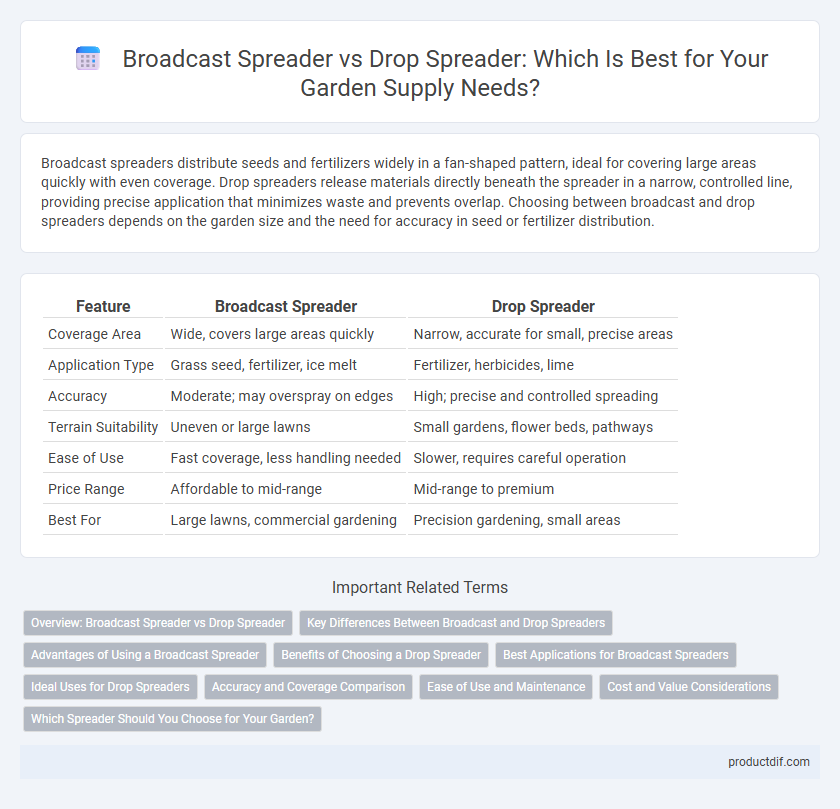Broadcast spreaders distribute seeds and fertilizers widely in a fan-shaped pattern, ideal for covering large areas quickly with even coverage. Drop spreaders release materials directly beneath the spreader in a narrow, controlled line, providing precise application that minimizes waste and prevents overlap. Choosing between broadcast and drop spreaders depends on the garden size and the need for accuracy in seed or fertilizer distribution.
Table of Comparison
| Feature | Broadcast Spreader | Drop Spreader |
|---|---|---|
| Coverage Area | Wide, covers large areas quickly | Narrow, accurate for small, precise areas |
| Application Type | Grass seed, fertilizer, ice melt | Fertilizer, herbicides, lime |
| Accuracy | Moderate; may overspray on edges | High; precise and controlled spreading |
| Terrain Suitability | Uneven or large lawns | Small gardens, flower beds, pathways |
| Ease of Use | Fast coverage, less handling needed | Slower, requires careful operation |
| Price Range | Affordable to mid-range | Mid-range to premium |
| Best For | Large lawns, commercial gardening | Precision gardening, small areas |
Overview: Broadcast Spreader vs Drop Spreader
Broadcast spreaders distribute seeds or fertilizers evenly over a wide area using rotating blades, making them ideal for large lawns and gardens. Drop spreaders release materials in a narrow, controlled path directly beneath the spreader, providing precise application for smaller or irregularly shaped areas. Choosing between a broadcast spreader and a drop spreader depends on the size of the garden, the need for accuracy, and the type of material being applied.
Key Differences Between Broadcast and Drop Spreaders
Broadcast spreaders disperse seeds and fertilizers over a wide area using rotating mechanisms, making them ideal for large lawns and uneven terrain. Drop spreaders release materials directly beneath the spreader in a precise line, providing better accuracy and minimizing product waste on small or tightly landscaped areas. The main difference lies in coverage pattern and control, with broadcast spreaders offering speed and breadth, while drop spreaders deliver precision and uniform application.
Advantages of Using a Broadcast Spreader
A broadcast spreader efficiently covers large garden areas with uniform distribution of seeds, fertilizer, or lawn care products, saving time and labor compared to drop spreaders. Its wide spreading pattern reduces the number of passes needed, ensuring faster application and consistent results. The adjustable settings allow precise control over spread rate, enhancing resource efficiency and minimizing waste.
Benefits of Choosing a Drop Spreader
A drop spreader offers precise application of fertilizers and seeds by delivering material directly beneath the spreader, minimizing waste and protecting surrounding plants from unintended coverage. Its controlled spreading pattern enhances accuracy, making it ideal for smaller gardens or areas requiring detailed attention. Choosing a drop spreader reduces the risk of uneven distribution and improves overall lawn health by ensuring nutrients reach targeted zones effectively.
Best Applications for Broadcast Spreaders
Broadcast spreaders excel in covering large areas quickly, making them ideal for lawn fertilization and seeding over expansive gardens or fields. Their wide dispersion pattern ensures even distribution of granular materials like fertilizer, grass seed, or pest control products without leaving gaps. Best suited for open spaces such as parks, sports fields, and large residential lawns, broadcast spreaders enhance efficiency and consistency in garden maintenance tasks.
Ideal Uses for Drop Spreaders
Drop spreaders are ideal for precise applications of fertilizers, grass seeds, and soil amendments in small to medium-sized gardens or lawns where control and accuracy are essential. They distribute materials directly below the spreader, minimizing waste and reducing the risk of overspreading onto sidewalks, driveways, or flower beds. Drop spreaders are preferred for spot treatments and delicate garden areas that require targeted nutrient distribution without affecting surrounding plants.
Accuracy and Coverage Comparison
Broadcast spreaders distribute seeds or fertilizer over a wider area with less precision, making them suitable for large lawns but prone to uneven coverage. Drop spreaders deliver materials directly below the unit in a narrow, controlled pattern, providing superior accuracy and uniform coverage ideal for detailed garden beds or small plots. Choosing between the two depends on the balance between speed and precision needed for specific garden tasks.
Ease of Use and Maintenance
Broadcast spreaders offer ease of use with wide, uniform coverage, making them ideal for large lawns and quick applications. Drop spreaders provide precise control and reduced waste, though they require more careful handling to maintain accuracy. Maintenance for broadcast spreaders often involves regular cleaning of the spinning mechanism, while drop spreaders need attention to the drop chute to prevent clogging and ensure consistent distribution.
Cost and Value Considerations
Broadcast spreaders typically cost more upfront than drop spreaders due to their larger capacity and wider coverage, making them suitable for extensive lawn care projects. Drop spreaders offer greater precision at a lower price point, providing excellent value for small to medium-sized gardens where targeted fertilizer application reduces waste and overspread. Choosing between these spreaders depends on balancing initial investment with long-term efficiency and the specific scale of garden maintenance.
Which Spreader Should You Choose for Your Garden?
Choose a broadcast spreader for even seed distribution over large areas such as lawns or flower beds, as it efficiently covers wide spaces quickly. A drop spreader offers precise placement ideal for planting rows or fertilizer application on smaller, more controlled zones, minimizing waste and avoiding overlap. Consider garden size and seed type to select the right spreader for optimal growth and resource use.
Broadcast spreader vs Drop spreader Infographic

 productdif.com
productdif.com